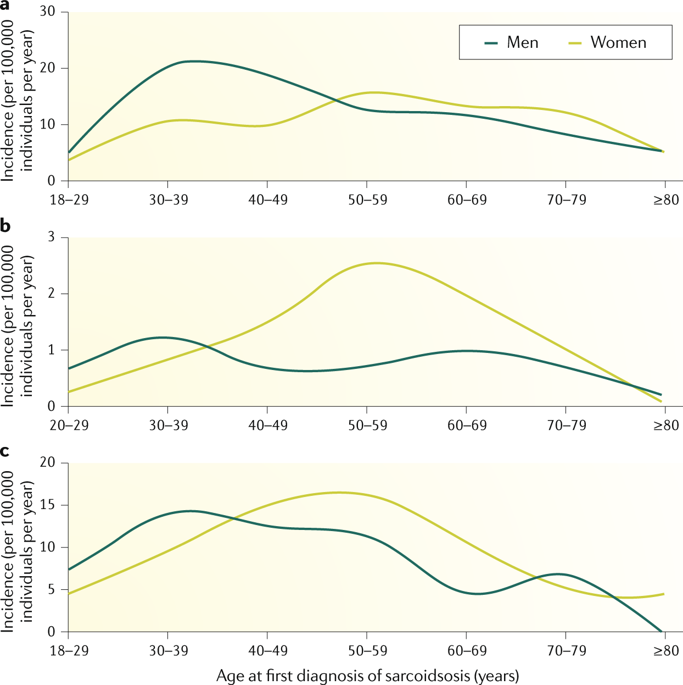当前位置:
X-MOL 学术
›
Nat. Rev. Dis. Primers
›
论文详情
Our official English website, www.x-mol.net, welcomes your
feedback! (Note: you will need to create a separate account there.)
Sarcoidosis.
Nature Reviews Disease Primers ( IF 76.9 ) Pub Date : 2019-07-04 , DOI: 10.1038/s41572-019-0096-x Johan Grunewald 1 , Jan C Grutters 2 , Elizabeth V Arkema 3 , Lesley Ann Saketkoo 4 , David R Moller 5 , Joachim Müller-Quernheim 6
Nature Reviews Disease Primers ( IF 76.9 ) Pub Date : 2019-07-04 , DOI: 10.1038/s41572-019-0096-x Johan Grunewald 1 , Jan C Grutters 2 , Elizabeth V Arkema 3 , Lesley Ann Saketkoo 4 , David R Moller 5 , Joachim Müller-Quernheim 6
Affiliation

|
Sarcoidosis is an inflammatory disorder of unknown cause that is characterized by granuloma formation in affected organs, most often in the lungs. Patients frequently suffer from cough, shortness of breath, chest pain and pronounced fatigue and are at risk of developing lung fibrosis or irreversible damage to other organs. The disease develops in genetically predisposed individuals with exposure to an as-yet unknown antigen. Genetic factors affect not only the risk of developing sarcoidosis but also the disease course, which is highly variable and difficult to predict. The typical T cell accumulation, local T cell immune response and granuloma formation in the lungs indicate that the inflammatory response in sarcoidosis is induced by specific antigens, possibly including self-antigens, which is consistent with an autoimmune involvement. Diagnosis can be challenging for clinicians because of the potential for almost any organ to be affected. As the aetiology of sarcoidosis is unknown, no specific treatment and no pathognomic markers exist. Thus, improved biomarkers to determine disease activity and to identify patients at risk of developing fibrosis are needed. Corticosteroids still constitute the first-line treatment, but new treatment strategies, including those targeting quality-of-life issues, are being evaluated and should yield appropriate, personalized and more effective treatments.
中文翻译:

结节病。
结节病是一种原因不明的炎症性疾病,其特征是在受影响的器官中形成肉芽肿,最常见的是在肺部。患者经常患有咳嗽,呼吸急促,胸痛和明显的疲劳,并有发展为肺纤维化或对其他器官不可逆转的损害的风险。该疾病在具有遗传易感性的个体中发展,该个体暴露于迄今未知的抗原。遗传因素不仅影响发展结节病的风险,而且影响疾病过程,该过程高度可变且难以预测。肺中典型的T细胞积累,局部T细胞免疫反应和肉芽肿形成表明结节病中的炎症反应是由特定抗原(可能包括自身抗原)诱导的,这与自身免疫相关。由于几乎任何器官都可能受到影响,因此对临床医生而言,诊断可能具有挑战性。由于结节病的病因尚不清楚,因此不存在特异性治疗方法,也没有病理标志物。因此,需要改进的生物标志物来确定疾病活动并鉴定有发生纤维化危险的患者。皮质类固醇仍构成一线治疗,但是正在评估新的治疗策略,包括针对生活质量问题的策略,这些策略应产生适当,个性化和更有效的治疗。需要改进的生物标记物来确定疾病的活动并确定有发生纤维化危险的患者。皮质类固醇仍构成一线治疗,但是正在评估新的治疗策略,包括针对生活质量问题的策略,这些策略应产生适当,个性化和更有效的治疗。需要改进的生物标记物来确定疾病的活动并确定有发生纤维化危险的患者。皮质类固醇仍构成一线治疗,但是正在评估新的治疗策略,包括针对生活质量问题的策略,这些策略应产生适当,个性化和更有效的治疗。
更新日期:2019-11-18
中文翻译:

结节病。
结节病是一种原因不明的炎症性疾病,其特征是在受影响的器官中形成肉芽肿,最常见的是在肺部。患者经常患有咳嗽,呼吸急促,胸痛和明显的疲劳,并有发展为肺纤维化或对其他器官不可逆转的损害的风险。该疾病在具有遗传易感性的个体中发展,该个体暴露于迄今未知的抗原。遗传因素不仅影响发展结节病的风险,而且影响疾病过程,该过程高度可变且难以预测。肺中典型的T细胞积累,局部T细胞免疫反应和肉芽肿形成表明结节病中的炎症反应是由特定抗原(可能包括自身抗原)诱导的,这与自身免疫相关。由于几乎任何器官都可能受到影响,因此对临床医生而言,诊断可能具有挑战性。由于结节病的病因尚不清楚,因此不存在特异性治疗方法,也没有病理标志物。因此,需要改进的生物标志物来确定疾病活动并鉴定有发生纤维化危险的患者。皮质类固醇仍构成一线治疗,但是正在评估新的治疗策略,包括针对生活质量问题的策略,这些策略应产生适当,个性化和更有效的治疗。需要改进的生物标记物来确定疾病的活动并确定有发生纤维化危险的患者。皮质类固醇仍构成一线治疗,但是正在评估新的治疗策略,包括针对生活质量问题的策略,这些策略应产生适当,个性化和更有效的治疗。需要改进的生物标记物来确定疾病的活动并确定有发生纤维化危险的患者。皮质类固醇仍构成一线治疗,但是正在评估新的治疗策略,包括针对生活质量问题的策略,这些策略应产生适当,个性化和更有效的治疗。











































 京公网安备 11010802027423号
京公网安备 11010802027423号